Health & Chemicals
Minamata Disease The History and Measures - Chapter 4
4. Measures against Minamata Disease
As we will describe below, many measures have been taken up to now against Minamata Disease.
(1)Measures against environmental pollution
Closing down of the pollutant sources
With regard to the Minamata plant of Chisso Co., Ltd., through the completion of the perfect circulation system in 1966, water effluent containing methylmercury compound had not been discharged outside of the plant in principle, and the pollutant source was eliminated through cessation of the production of acetaldehyde in 1968. In the Agano River basin the process of producing acetaldehyde had already closed before Minamata Disease was discovered.
Effluent control
In 1969, drainage of the factory effluent containing methylmercury to Minamata Bay was regutated. In 1970, the Water Pollution Control Law was enacted, which enforced control of discharge of effluent in all water areas in Japan, in relation to toxic substances, for example, mercury and cadmium. Furthermore, conversion of the production method was advised against caustic soda plants that might discharge mercury other than Chisso and Showa Denko plants.
Restoration of the environment
Because methylmercury remained a considerable concentration in bottom sediment of the related water areas even after the discharge of the methylmercury compound was stopped, in order to remove this bottom sediment, from 1974 to 1990, Kumamoto Prefecture carried out the project for dealing with about 1,500,000 cubic meters of bottom sediment of Minamata Bay that contained mercury more than the removal standard (25ppm of total mercury) by means of dredging and landfill, and for making 58ha. landfill, at a total cost 48 billion yen (of this total, the responsible company bore 30.5 billion yen). In 1976, Niigata Prefecture carried out dredging river bottom sediment that contained mercury more than the removal standard around the drainage outlets of Showa Denko plant by the burden of the responsible company.
- Fig. 4: Dredging of Minamata Bay
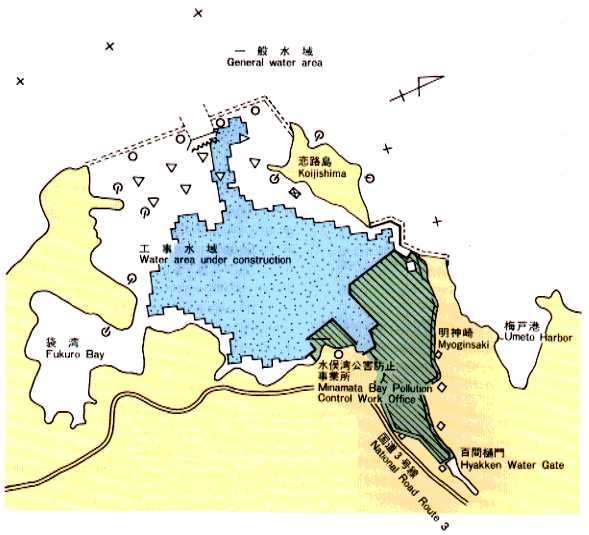
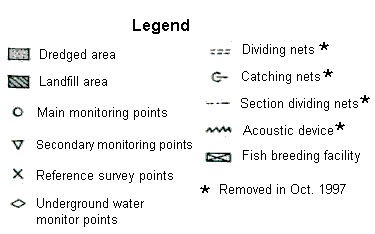
| Area | Treated area | Volume of sludge disposed |
|---|---|---|
| Landfill area | 582,000 m2 | 726,000 m2 |
| Dredged area | 1,510,000 m2 | 784,000 m2 |
| Total | 2,092,000 m2 | 1,510,000 m2 |
Restraint on intake of fish and shellfish, and compensation to the industry
In the area around Minamata Bay, in 1956, when it became clear that intake of fish and shellfish might be the cause of the disease, the control of intake of fish and shellfish taken from Minamata Bay and self-restraint of work by the fishing cooperative are started by guidance of Kumamoto Prefecture et al. This guidance had lasted with some interruptions until early in October 1997, when the dividing nets in Minamata Bay were completely removed. During this period, Chisso Co. Ltd. paid to the fishing industry as compensation, 140 million yen in 1959 fiscal year (FY), 3,930 million yen in 1973-74 FYs, and 950 million yen in 1992-98 FYs.
In the Agano River basin, after June 1965, when Minamata Disease was just discovered there, Niigata Prefecture took measures that are guidance for the concerned fishing cooperative to self-restrain catching fish and shellfish, and for the concerned people to control intake.
- Fig. 5: Transition in Pollution Level of fishes
-
Minamata Bay Area
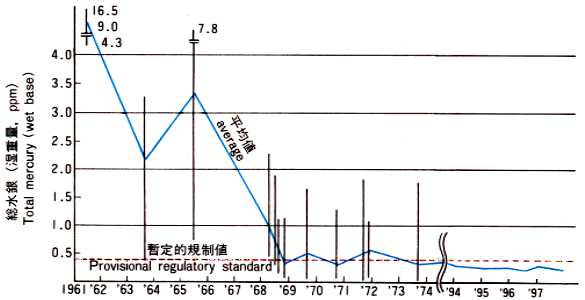
Agano River Basin
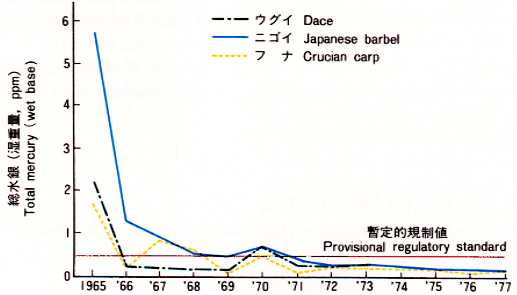
(Note)
The provisional regulatory standard for fish has been established, stipulating 0.4 ppm for total mercury and 0.3 ppm for methylmercury.
Transition in conditions of pollution
In the area around Minamata Bay and the Agano River basin, until now various types of investigations about water quality, bottom sediment, fish and shellfish, hair sample, etc., have been carried out with respect to environmental pollution As a result, it is thought that continuous methylmercury exposure at the level which could cause Minamata Disease existed until no later than 1968 in the area around Minamata Bay, and until no later than 1965 in the Agano River basin, and that, from that time, there has not been such exposure that could lead to the occurrence of Minamata Disease.
Monitoring of methylmercury concentration of fish and shellfish continues even today in the area around Minamata Bay and in the Agano River basin.
(2)Relief of Minamata Disease patients
Relief based on the law
At the beginning of outbreak of Minamata Disease, the concerned local government had provided Minamata Disease patients particular financial assistance for medical expense.
However, because matters of health damage caused by pollution had become obvious all over Japan since 1960s, the Law Concerning Relief of Pollution-related Health Damage was enforced in 1970, under which benefits for medical expense, cost for hospital visits, etc., were provided for sufferers of pollution-related health damage, and Minamata Disease of Kumamoto and Niigata became subject of the law. Then in 1974, based on liability for damages of a civil suit, the Pollution-related Health Damage Compensation Law [now the Law Concerning Compensation for Pollution-Related Health Damage and Other Measures (hereinafter referred to as the Compensation Law)] was enacted, under which income compensation was provided in addition to medical expense for sufferers of pollution-related health damage, so the content of relief provided to sufferers of pollution-related health damage has been improved.
- Fig. 6: Diagram of the Minamata Disease Certification System
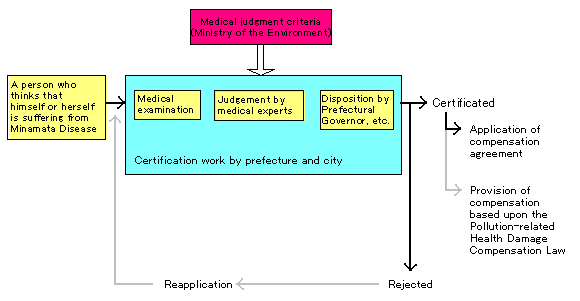
As a result, compensation based on the Compensation Law is provided to those who are certified as patients of pollution-related disease based on the Compensation Law by the charge of the responsible company for pollution, so sufferers of pollution-related health damage can receive compensation without raising suits and proving of their own accord the causal relationship between the pollution and the their disease. However, with regard to Minamata Disease, because the agreement which provides payment of a large amount of compensation was concluded between the responsible company and the patients, those who are certified as Minamata Disease patients based on the Compensation Law receive compensation from the responsible company based on the agreement. Certification that they suffer from Minamata Disease is carried out by the concerned prefectural government based on the result of medical examination and consideration by medical specialists concerned with Minamata Disease, and those who are consistent with the diagnostic criteria which was decided as the minimum requirement to distinguish medically from other disease, are broadly certified as patients of Minamata Disease.
Through this system, 2,955 persons have been certified as Minamata Disease patients in the Yatsushiro Sea area and the Agano River basin, and a total of approximately 144.1 billion yen has been paid as compensation from the responsible companies (As of March, 2001).
At the present time, it is unthinkable that Minamata Disease newly occurs, but the work of certification based on the Compensation Law still continues, because there are some people who apply for certification repeatedly even after rejections to the former application, and who did not apply in the past for some reasons and first apply recently. Because patients who have most of signs and symptoms that is characteristic of Minamata Disease had already applied for certification and had been certified from the start of this system to now, almost all of the people who apply now are those who cannot be certified medically as Minamata Disease or are difficult cases to be medically decided.
- Fig. 7: Transition in the Number of Certification

- Table 3. Comparison of the Payment of Compensation Under Compensation Agreement and the Payment of Compensation Under the Compensation Law
(In the case of a man aged 65 years or older (more than half of Minamata Disease patients are in this category) who is suffering from the severest degree of disabilities) -
Item Amount per patient (as of April, 2001) Compensation Agreement (Between Chisso Co. and the Patients) The Compensation Law Benefit related to the medical Expense Medical expense: Total amount of medical expense related to Minamata Disease Provision of medical treatment and treatment expense:
Total amount of medical expense related to Minamata DiseaseDirect cash benefit
(Lump-sum benefit)Solatium About 22million yen
(Average (per capita) of actual compensation. Depending on the situation of relaitions)(Continuous benefit) Life-time special adjustment allowance
169,000 (yen/month)Disabillty compensation benefit
221,700 (yen/month)Benefit related to the cost of
Non-medical careCost of non-medical care: Equivalent to the benefit paid under the Compensation Law.
Allowance for care assistant:
24,000 (yen/month)Additional benefit for care
48,100 (yen/month)Benefit related to the cost of health
Services, etc.Medical allowance:
Equivalent to the benefit paid under the Compensation LawTreatment allowance (ex. For hospitalization of 15 days or more) 36,400 (yen/month) Benefit related to the cost of funerals, etc. 644,000 yen 661,000 yen Others Acupuncture, moxibustion, massage, hot spring treatment, etc.
urvey of health damage
In the area around Minamata Bay, the research to investigate the cause and the nature of Minamata Disease was carried out mainly at the beginning of outbreak of Minamata Disease, and the first full-scale survey to grasp the extent of the health damage was the one on about 110,000 habitants of the area around Minamata Bay in 1971 after the cause of the Minamata Disease was made clear. In the Agano River basin, immediately after the discovery of patients, a series of health surveys on the inhabitants were carried out by the prefectural government, and the scale of the survey has been approximately 80,000 for cumulative total of objects.
(3) Environment health measures for inhabitants
At the present time, there is no possibility of exposing to methylmercury that could lead to the occurrence of Minamata Disease and no evidence that intake of such a level of methylmercury results in any effect on health. However, in the area where there had been an outbreak of Minamata Disease, because fish and shellfish polluted with methylmercury were widely distributed and eaten in the past, even there is a possibility that those who did not fall Minamata Disease may have been exposed to various levels of methylmercury, and the anxiety about health effect of methylmercury exits among inhabitants of the concerning area.
In order to reduce and get rid of the matter of health in these area, the Government takes the Task of the Comprehensive Measures against Minamata Disease from fiscal year of 1992, which consists of the Task of Health Care that is to do periodic health examination for inhabitants, etc., and the Task of Medicine that is to provide medical expense and medical allowance as a cost related medical treatment to those who suffer from neurological signs and symptoms similar to those of Minamata Disease.
(4) Financial assistance to the responsible company
Compensation for patients of Minamata Disease in the Yatsushiro Sea area is being carried out by Chisso Co., Ltd. Because of limitation on its solvency of the compensation and the burden charge of the dredging project, necessary financial assistance is designed to ensure that there will be no interruption in the payment of compensation, maintaining the basic principle of the responsible company bearing the burden.
(5) Promotion of research and investigation
With regard to Minamata Disease, a large number of researches and investigations have been carried out since before, and many facts have been clarified; the clinical feature of Minamata Disease, the mechanism of damage to the living body caused by methylmercury, etc.
The Government has provided broad range of support to these researches and investigations, and has actively carried out its own researches and investigations including establishment of the National Institute of Minamata Disease (NIMD) for comprehensive research program. The Institute was designated as a cooperating institution of WHO in 1986. In 1996, NIMD was reorganized, it is aiming to provide accumulations of Japanese experiences related to the mercury poisoning with the request from other countries, and to make contribution in terms of international cooperation in the field of environmental health.